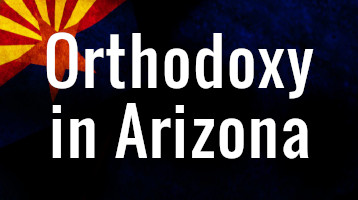
by Vladimir Lossky
The feast of Mid-Pentecost occupies a place (Wednesday of the fourth week after Pascha) between the Resurrection of Christ and the Descent of the Holy Spirit [Pentecost], and thus it is adorned with the especial glory characteristic of “the root of the greatest feasts” (see Matins, the canon of Theophanes, Ode 5). Just like the majority of “ideological” feasts, this mysterious celebration of grace (unknown in the West), apparently dates back to deep antiquity. In fact, our present-day feast of Pentecost contains, besides the stichera of a later period (early eighth century), liturgical elements ascribed to Holy Hierarch Elias of Jerusalem (494–513) or Holy Hierarch Anatoly of Constantinople (449–458).
The Gospel reading for Mid-Pentecost (see Jn. 7:14–30), which begins with the words,
Now about the midst of the feast (τῆς ὲορτῆς μεσοὑσης) Jesus went up into the temple, and taught,
relates to the event that occurred in the middle of the feast of tabernacles. However, this Jewish feast, celebrated for seven or eight days in the autumn (in September–October), was clearly distinct from the Feast of Pentecost. Yet the Jewish “Mid-feast of Tabernacles” is recalled within the Christian Pentecost because it was on the last great day of that feast—
the last day, that great day of the feast (John 7:37–39)
—that Christ spoke of the coming of the Holy Spirit, which was to take place shortly after His Passion and glorification. The Gospel reading for the day of Pentecost (see John 7:37–52; 8:12) begins precisely where the reading for Mid-Pentecost ends, and it contains the promise of the Holy Spirit in the image of rivers of living water. This theme of living water as an image of grace constitutes the leitmotif of the divine services for Mid-Pentecost, thus justifying the transfer of the symbolism of the Feast of Tabernacles to Pentecost.
Unlike the divine services, the iconography of the Mid-Feast of Pentecost did not develop the “water theme.” It is quite restrained, and shows us Christ in the Temple, talking with the elders. He does not stand as He does on the “last day of the feast,” when He spoke of living waters, but sits on a semi-circle bench in the center of the icon. Six elders sit with covered heads in groups of three on either side of Christ, and comprise two harmonious, equal groups. Their poses and gestures express amazement, from which we can conclude that the icon simply conveys the following part of the Gospel reading for the feast:
How knoweth this man letters, having never learned? (Jn. 7:15).
The same is true of the fresco of the Midfeast in the Church of St. Theodore Stratelates in Novgorod (14th century). There, the bearded Christ is shown seated, preaching to the elders gathered around Him. Our icon, however, is not merely a pictorial retelling of the Gospel passage concerning the “middle of the feast” of Tabernacles; here the teaching Christ (as shown by the gesture of His right hand and the scroll in His left) is clearly depicted as a beardless youth—as He would have appeared at age twelve, when He first astonished the doctors of the Law in the temple with His wisdom:
The same teaching Christ Emmanuel is also depicted, for example, in the Byzantine illuminated Gospel from the Paris National Library (see Paris manuscript, gr. 74, fol. 98, 11th or early 12th c), which illustrates St. Luke’s story of Christ’s childhood. As opposed to this manuscript, on our icon, Mary and St. Joseph are absent. If the features of Christ Emmanuel on the icon of Mid-Pentecost point to the first relating of God’s Wisdom in the Jerusalem temple according to the Gospel of St. Luke (the Gospel reading for the feast of the Circumcision), then this does not replace the Messiah’s last sermon in the same temple, but rather points to the connection between the beginning and the end, to the unity of the teaching of the Son of God, sent by the Father into the world
Wist ye not that I must be about my Father’s business? [Lk. 2:49],
and Ode 6 of the canon for Mid-Pentecost:
“While standing in the temple, O Christ, Thou didst speak unto the assemblies of the Jews and didst reveal Thine own glory, thereby manifesting Thy consubstantiality with the Father”
The type of Emmanuel also underscores both Christ’s existence outside of time, and the truth of His having become man: The incarnate Word passed through childhood and youth. And in each age of His earthly life, the Lord remains the immutable Wisdom of the Father, Who first showed Himself to the scribes in His youth. On the icon of Mid-Pentecost, Christ Emmanuel corresponds to the hymnography of this feast, which speaks of the “Wisdom of the Father”—ἡ Σοφἱα τοῦ Θεοῦ—Who has come to the “middle of the feast” in order to promise the water of immortality.
Our icon, which goes back apparently to the fifteen century, is an excellent example of the best tradition of the Novgorod school. The composition is precise and restrained: Christ stands out in the center against the architectural background, and the two groups of elders, whose gestures express restrained amazement, further emphasizing the magnificent peace of the Youth Who teaches them. Notable in the colors is the same striving for restraint: Emmanuel’s garments of glory are portrayed by ochre and gold, and in the elders’ garments only three colors are used: cinnabar, purple, and hazel, supplemented by white head coverings and a white wall, creating the impression of great richness, achieved through extremely modest means.



